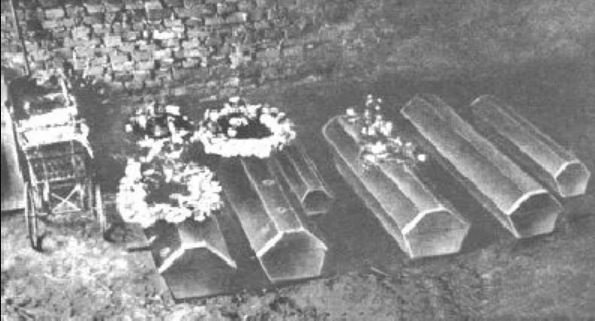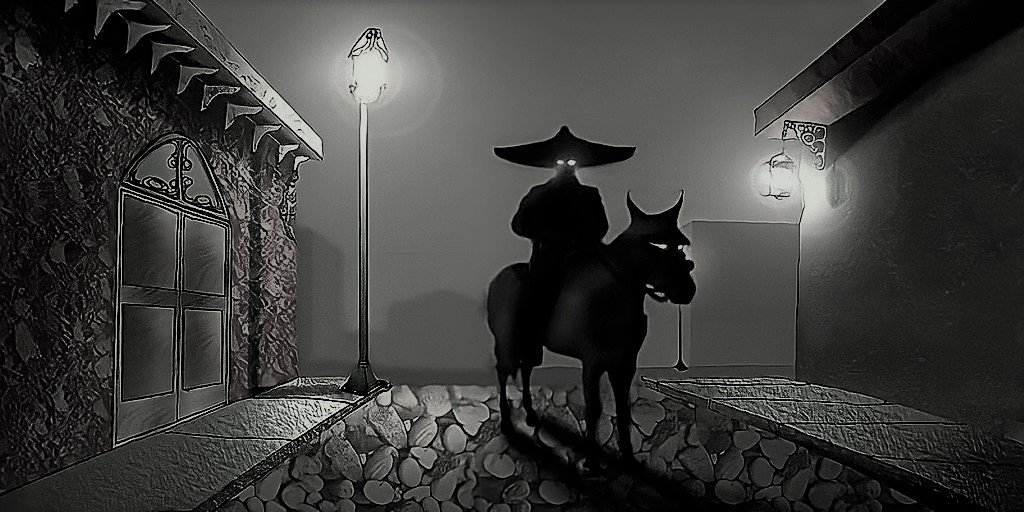The Hinterkaifeck Murders of 1922, Germany
In April 1922 a family of six was found murdered on their farm having been bludgeoned to death. Evidence revealed the family had been dead for days but witnesses claimed to have seen someone living in the home just the day prior. Chillingly this meant the murderer spent almost a week living on the farm while the family lay rotting in the barn.
To this day the identity of the killer is still a mystery but, were there ominous signs six months prior to the killings? Is it possible that the farm was as haunted as many others believed? Or could the killer have been someone close to the family?
Part 1 - Strange Happenings at Hinterkaifeck
"We ask only to be reassured about the noises in the cellar and the window that should not have been open."
T.S. Elliot
The Grubers
Hinterkaifeck was a small farmstead surrounded by forests that lay between two Bavarian towns about 40 miles or 70 kilometers north of Munich. The Gruber's, consisting of husband and wife; 63-year-old Andreas and 72-year-old Cazilia, their widowed 35-year-old daughter Viktoria and their two grandchildren 7-year-old Cazilia and 2-year-old Josef; along with a maid, all lived on the farm.
The family themselves were not well-respected in the neighboring towns due to their scandalous reputation. It was widely known Viktoria and Andreas were accused and convicted of having an incestuous relationship that many believe led to the birth of Josef.
As incest was a crime in the area, Andres was sentenced to a year in jail while Viktoria was sentenced to a month. Due to their reputation, the family was reclusive with only Viktoria and her daughter Cazilla being regularly seen in the town. This meant if the family wasn’t seen in town for several days, no one would it was a big deal and they certainly wouldn’t have suspected foul play.
Strange Happenings
In September 1921, the family’s maid suddenly quit. According to reports, she claimed the farm was haunted, and could no longer live there without fear. She is said to have told the police of random footsteps and other strange sounds she would hear coming from the empty attic in the middle of the night.
Though this is commonly reported, I could only find her police interview where she said the door would open on its own every night at midnight. Regardless of whatever she experienced, it was enough to make her quit in fear of something supernatural.
After her departure, Andreas reportedly told several of his neighbors he didn’t believe her claims but just a few months later, he heard the same sounds. After initiating his own search, Andreas found nothing out of the ordinary and refused help from his neighbors in continuing or starting a new search.
Towards the end of March 1922, a snowstorm hit the Hinterkaifeck farmstead. As a thin layer of snow covered the land, Andreas made a terrifying discovery. He found a set of footprints emerging from the woods and leading to the farm's machine room.
The lock on the machine room door had broken several weeks prior but thinking nothing of it, Andreas never replaced it. Now it appeared as if someone was using for as shelter.
Andreas searched the machine room, other portions of the farm, and the house but found nothing. Despite coming to the conclusion that no one was there, there was a dreadful feeling knowing that no footprints were found leading back to the woods.
Over the course of the next few days, Andreas also discovered a newspaper that neither he nor anyone else in the family had purchased. At the time newspapers were by subscription or had to be purchased in town and yet no one in the family or the neighbors subscribed to that specific paper.
Neighbors would later claim that members of the family mentioned some house keys going missing and constantly seeing a stranger with a mustache wandering around the outskirts of the farm.
On Friday, March 31st, 1922 a new maid, 44-year-old Maria Baumgartner arrived for her first day of work at the Gruber Farmstead.
Unfortunately, her first day would also be her last.
Part 2 - The Murder & Preliminary Investigation
“It strikes me profoundly that the world is more often than not a bad and cruel place.”
Bret Easton Ellis, American Psycho
By April 4th no one had seen the Gruber family but a few had seen instances of life in the farmstead, unbeknownst to them it was not from anyone in the family.
On April 1st, artisan Michel Plockl noticed smoke coming from the chimney and also claimed to have seen someone outside with a lantern, though he couldn’t identify them. The following night farmer and butcher Simon Reiblander saw two strangers at the edge of the forest who turned away as he approached them.
On April 3rd suspicion arose when the postman delivered mail and noticed the mail from Saturday had not been touched. The following day, repairman Albert Hofner arrived at the farm to fix an engine in the farm's machine room. He did not see any of the family but noticed the barn doors locked and heard the family dog barking inside.
At that moment Albert didn’t think much of the scene and since the farm’s machine room was open, he headed in to fix the engine. Four hours later his work was complete but, as he was leaving the farm, he noticed the barn door was open and the dog was now tied up outside despite him never seeing or hearing the family as he worked.
Arriving back at the town, Albert’s shared his eerie experience with the town’s local guide, Lorenz Schlittenbauer. Growing worried as he had also not seen the family, he decided to head to the farm with two of his friends at around 3:30 pm.
Discovery at Hinterkaifeck
The three men arrived at the house but found every door locked with no evidence of anyone inside. Seeing the barn door open, they entered and immediately discovered the bodies of Andreas, his wife Cazilia, daughter Viktoria, and granddaughter Cazilia stacked atop of each other covered in hay.
Lorenz moved all the bodies attempting to determine if any were still alive. Realizing that young Josef was not in the pile of bludgeoned bodies, Lorenz ran into the home through a connecting hallway in the barn and continued his search. Inside, he found the lifeless and bloodied bodies of Maria and Josef in his bassinet.
Hours later inspector Georg Reingruber from the Munich Police Department arrived to investigate but, he first had to travel 45 miles to get there. In the small town, news, especially that of murder, spread much quicker than the police could ever arrive.
Many reports detail some of the townsfolk trampling around the crime scene, moving evidence, and even cooking and eating meals while they were there.
An autopsy of the bodies performed the following day revealed the family had been killed with a mattock or a pickaxe. Horrifyingly all but the younger Cazilla had died instantly from pickaxe blows to the head. Cazilla was alive for several hours after the attack, the shock and trauma of her attack and watching her family killed caused her to pull her own hair out in her final hours.
Timeline
With the information at the scene and after several interviews with neighbors, the police were able to piece together a timeline. An interview with Maria Baumgartner’s sister confirmed Maria’s first day was March 31st and her sister stated she had visited Maria that same day.
An interview with the mailman confirmed the mail hadn’t been disturbed since Saturday morning which told police the Grubers were murdered on the night of March 31st. That night, the killer or killers somehow led the family into the barn one by one. Possibly by calling out to each or causing a disturbance in the barn.
As each entered the barn they were struck in the head with the pickaxe. Viktoria and her mother Cazilia also showed signs of strangulation, it’s possible they were strangled and then struck to ensure the job was done.
All four had received multiple blows to the head with Viktoria herself having been struck upwards of nine times by the mattock. The killer then made their way into the home, killing Maria in her room. The final victim was young Josef, who was struck just once, killing him instantly.
Other interviews with neighbors and their own investigation revealed a more disturbing side to the killer. In the days following the murders, witnesses noticed smoke emanating from the chimney and several believed they saw one of the Grubers outside of the home.
The police also noticed the dog and cattle had been fed, the cows had been milked, and food had been cooked. Whoever committed the gruesome murders, lived on the farm for several days and knew exactly how to tend to it.
Finally, after interviewing Albert, the police realized the killers had been in the house the day of the discovery and no one noticed them leave. Were they still there when the police arrived? Were the killers one of the neighbors?
Part 3 - The Suspects and Theories
“The belief in a supernatural evil is not necessary. Men alone are quite capable of every wickedness”
Joseph Conrad
The Thaler Brothers
The first theory that came to the police's mind was a robbery. In an interview with the Gruber’s former maid, Kreszenz Rieger, she revealed that a man named Josef Thaler had visited the farm almost a year prior to the murders. Josef Thaler and his brother were known in the area as a pair of thieves that had committed multiple minor burglaries in the area.
On one random night, Josef knocked on Kreszenz's window and after ignoring him for some time, she relented and asked what he wanted. Josef appeared to hint at wanting to rob the farm and asked Kreszenz if she knew where the family slept.
Kreszenz refused to answer his questions and played dumb in her answers. While Josef spoke with her, she noticed someone moving around in the bushes behind Josef but he claimed he was alone. Despite this, Kreszenz witnessed him leave with someone who she assumed was his brother. She also witnessed the two men stand by the barn and look toward the roof.
To add to the police’s suspicions, Kreszenz stated the brothers had hidden in the barn two years prior and Andreas had forced them out by shooting toward them with a rifle.
While the Thaler brothers seemed like strong suspects, the police found money, gold, and jewelry left at Gruber’s home after the murders. Whoever killed them, didn’t do it for the money.
Adolf and Anton Gump
Days after the murders, Inspector Reingruber suspected a man named Adolf Gump to have been involved in the killings.
Although Adolf was rumored to have been in a relationship with Viktoria, It’s not clear if there was any other evidence to tie him to the family or to place him at the scene.
Previously Adolf had been suspected, along with three others, to have taken part in the killing of nine peasants in 1921 but if this was all Reingruber had to go on, it was flimsy at best. Unfortunately, Adolf could not be located and was never questioned.
Thirty years later in 1951, Adolf’s sister, Kreszentia Mayer, made a deathbed confession. She claimed her brothers Adolf and Anton were the Grubers’ killers. Hearing this, prosecutor Andreas Popp placed Anton Gump into custody but he was unable to question Adolf as he had died in 1944 during the Second World War.
Without more evidence to prove the brother’s involvement and with Anton’s claims of innocence, Anton was released and the case against him was dropped by 1954.
Karl Gabriel
The next suspect police looked at is Karl Gabriel, the dead husband of the widowed Viktoria.
Karl Gabriel was thought to have been killed in France in December 1914 during the First World War. But, when word spread that his body was never found, one of the more unusual theories about the murders was formed.
After many failed attempts to find a killer, people began to theorize that Karl Gabriel had not in fact died at war and upon making his way back to the farm, learned of Viktoria’s son. Either angry about the possibility of the incestuous relationship between Viktoria and Andreas or just the fact that she had a son with another man, many believed Karl took out his anger on the entire family.
This theory, in what seems like a hail-mary attempt, was even reviewed by police. It didn’t help that many people, in the years following, claimed to have seen a man matching the description of Karl Gabriel in the area during and after the murders.
After several interviews with fellow soldiers, police confirmed Karl Gabriel did die in the first world war as multiple soldiers witnessed him laying lifeless after a shell attack in France. Yet, for some reason, Karl Gabriel still comes up in various articles as a legitimate suspect.
Lorenz Schlittenbaur
While there are multiple other suspects that have come to light over the decades, none appear to have strong evidence tying them to the murders. But the final suspect we’ll look at today is, in my opinion, the suspect with the strongest ties.
Lorenz Schlittenbaur was the town’s tour guide and the man who discovered the bodies but, he had secret links to the family that make him the most viable suspect.
His initial reactions, the moving of the bodies at the crime scene, and running into the home alone seemed immediately suspicious to many. Although forensics back then were not up to par with today, many still knew they shouldn’t touch or move bodies.
Witnesses stated his reactions to the discovery of the bodies also did not seem normal. He was calm and displayed no disgust at the sight of the bloodied corpses. It was also reported Lorenz had a key to the home harking back to the missing keys Andreas reported before his death.
When questioned by police, Lorenz explained away his abnormal reactions by confirming a rumor that was being spread about his relationship with the Gruber family. Lorenz claimed he was young Josef’s father and the reason he pushed the bodies aside after finding the family, was to search for his son.
But police pointed out that Lorenz had, in the past, denied being the father of Josef. Lorenz claimed he only did this when the incest allegations between Viktoria and Andreas made him question the paternity. Lorenz’s attempts to prove his innocence backfired when the police discovered records showing Viktoria attempted to get the courts to mandate alimony payments from Lorenz.
Theories suggest Viktoria was successful and Lorenz committed the murders to get out of making the payments as he was already in financial trouble and had another family. Several witnesses came forward claiming to have seen Viktoria and Lorenz arguing about the payments and paternity of Josef as recently as the day of the murders.
Others have claimed that Lorenz truly did not believe he was the father of Josef and only did so, after the murders, in order to claim a possible inheritance.
Lack of Evidence and Real Suspects
Despite all the allegations and theories, they are just theories and the lack of any real evidence prevented the police at the time from solving the case.
For Lorenz, he stated the reason he moved the bodies and his lack of reaction to them was because he was honed in on trying to find his son. His reactions after the fact, which appeared to display no emotion could easily have been chalked up to shock.
With no substantial evidence, the police had no reason to arrest him. Despite this many claimed he did commit the murders but Lorenz fought every accusation in court and won many cases of slander until his death in 1941.
All in all, the police suspected one hundred different individuals yet no one was ever arrested or charged with the crimes. The case was closed in 1955 but remained in the minds of many for generations to come.
In 2007 a group of students at a police academy in Germany investigated the crime using modern forensics. Although they stated it would be impossible to solve the crime after all this time, they did come up with a prime suspect. But, they refused to name the suspect out of respect for the suspect’s descendants.
The case is now one hundred years old and it’s almost a certainty that these gruesome murders will never be solved. Though many have and will continue to spend more years and decades trying to find the killer in order to bring justice to the family that lived at the Hinterkaifeck farmstead.
One thing is clear, the lives of six were tragically and unceremoniously taken away by a person or persons filled with evil and hatred.
Other Sources
Learn a Little Bit of Everything!
Myths, Mysteries, & Monsters


















